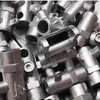Mobile:+86-311-808-126-83
Email:info@ydcastings.com
aluminum bronze casting
Aluminum Bronze Casting Properties, Applications, and Advantages
Aluminum bronze casting is a specialized process that involves the production of bronze alloys containing aluminum, along with other elements such as iron, nickel, and manganese. These aluminum bronze alloys are known for their remarkable physical and mechanical properties, making them an excellent choice for various applications across multiple industries. In this article, we will explore the properties of aluminum bronze, its casting methods, its applications, and the advantages it offers.
Properties of Aluminum Bronze
Aluminum bronze is distinguished by its unique combination of strength, corrosion resistance, and wear resistance. One of the significant characteristics of aluminum bronze is its high tensile strength, which can range between 500 to 800 MPa, depending on the exact composition and heat treatment of the alloy. The presence of aluminum in the alloy improves its resistance to oxidation and corrosion, particularly in seawater and other challenging environments, making it ideal for marine applications.
Additionally, aluminum bronze exhibits excellent resistance to wear, which is critical in applications where materials are subject to friction and abrasion. The alloy also has a relatively low thermal conductivity but maintains good thermal stability, making it suitable for high-temperature environments. Notably, aluminum bronze is non-sparking, which adds to its safety profile in applications involving flammable materials.
Casting Methods
The casting of aluminum bronze can be achieved through several methods, including sand casting, investment casting, and centrifugal casting. Each method has its advantages and is chosen based on specific application requirements.
1. Sand Casting This is one of the most traditional and widely used casting methods. It involves creating a mold from sand, which can be easily shaped and reused. Sand casting is particularly suitable for large parts and provides excellent detail and surface finish.
2. Investment Casting Also known as lost-wax casting, investment casting allows for the production of intricate shapes and high precision components. In this method, a wax pattern is coated with ceramic to form a mold, which is then heated to remove the wax. The molten aluminum bronze is poured into the mold, resulting in a high-quality finish with minimal machining required afterward.
3. Centrifugal Casting This method involves pouring molten metal into a rotating mold, which ensures an even distribution of the alloy and can help eliminate impurities. Centrifugal casting is often used for producing cylindrical components and offers good mechanical properties.
aluminum bronze casting

Applications of Aluminum Bronze
Aluminum bronze has a wide range of applications due to its unique properties. It is widely used in marine environments for components such as propellers, pumps, and valve bodies. Its corrosion resistance makes it ideal for offshore structures and underwater applications.
In the aerospace and automotive industries, aluminum bronze is often used for bearings, bushings, and wear plates due to its ability to withstand wear and maintain structural integrity under high-stress conditions. Furthermore, in the construction industry, aluminum bronze is utilized for architectural features, fittings, and hardware because of its aesthetic appeal and durability.
Advantages of Aluminum Bronze Casting
The casting of aluminum bronze offers several advantages. Firstly, the combination of strength and corrosion resistance significantly extends the lifespan of components, reducing the need for frequent replacements and maintenance. This is particularly valuable in industries where downtime can be costly.
Secondly, aluminum bronze components can be produced with high precision and intricate designs through methods like investment casting, enhancing overall product quality and reducing material waste during production.
Lastly, the non-sparking characteristics of aluminum bronze make it a safe choice for hazardous environments, further broadening its applicability across various sectors.
Conclusion
In summary, aluminum bronze casting is a versatile and robust manufacturing process that brings together the beneficial properties of aluminum bronze alloys. With applications ranging from marine to aerospace, its corrosion resistance, strength, and durability make it a preferred material for many industries. As technology advances, the methods and techniques for casting aluminum bronze will continue to evolve, unlocking new potentials and applications for this exceptional material.
-
Understanding Metal Casting TechniquesNewsApr.02,2025
-
Understanding Exhaust Manifolds for Enhanced Engine PerformanceNewsApr.02,2025
-
The World of Metal FabricationNewsApr.02,2025
-
Key Components for Pump and Turbo EfficiencyNewsApr.02,2025
-
Essential Tools for Automotive Maintenance and RepairNewsApr.02,2025
-
Durable Valve Components for Effective Water ManagementNewsApr.02,2025











